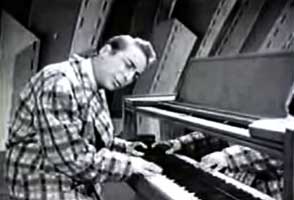 Harry "the hipster" Gibson is a complete oddball dressed in a suit with giant checkerboard design hunched over his piano pounding out the titular instrumental Opus 22 EEE (1944) which has at least once been retitled (by someone adverse to Harry's eccentricity) Piano Boogie Jump. Harry "the hipster" Gibson is a complete oddball dressed in a suit with giant checkerboard design hunched over his piano pounding out the titular instrumental Opus 22 EEE (1944) which has at least once been retitled (by someone adverse to Harry's eccentricity) Piano Boogie Jump.
Gibson's a great musician blending jive & barrelhouse as he pounds out his boogie woogie like Jerry Lee Lewis poundng out rock n roll. Indeed, in this three minutes of wild abandon we are given a glimpse of the birth of white rock & roll. At one point he's perched on his piano stool like a tree-kangaroo never missing a beat.
The set is an expressionist city scape, as well it might be, Harry having been a Bronx Jew whose live performances were primarily in the club scene of Manhattan. After Harry's been flying for a while, out come a group of young dancers, two guys & three gals, & they boogie like dream-teenagers from the dimension of cool.
Though he's not singing in Opus 22 EEE, Harry was a hipster poet precursor to the Beats & even the hippies. And wild as his performance looks on this little soundie, he's toned himself way down.
Harry the Hipster recorded these soundies for Phonvue, a rival of the Mills Panoram. I've seen one copy of Opus 22 EEE that had a lead-in shot of the Phonuvue & shadows of a group of dancers behind it. On the screen of the Phonovue is a fragmetn of the Harry Gibson soundie about to begin.
This type of lead-in is occasionally encountered by which it's instantly recognized as a Phonovue soundie, which displayed the films as more of a widescreen film compared to the Panoram.
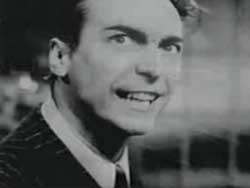 The daringness of Harry got him in trouble from time to time, as his tune 4-F Ferdinand might convey. In the '40s when many of the film-playing jukeboxes were aimed at soldiers on leave, a tune in praise of a guy who won't be drafted. The daringness of Harry got him in trouble from time to time, as his tune 4-F Ferdinand might convey. In the '40s when many of the film-playing jukeboxes were aimed at soldiers on leave, a tune in praise of a guy who won't be drafted.
The setting is made to look like a rather upscale club, like some that Harry played in Manhattan. He's in a black suit at a grand piano, pounding out the boogie woogie number.
"4F" was the designation for undraftable as opposed to "1A" the first choices to draft. 4F Ferdinand has every excuse in the book for not being drafted, just like stoned hippy peaceniks using everything from sissification to drug abuse to whatever disease was handy to keep from having to be soldiers.
So Harry was two decades ahead of its time with such lyrics as: "They call him 4F Ferdinand the frantic freak/ He's got a face like a fish & two flat feet/ He's as flippid as a frog, fat as a hog, fickle as a female virgin in a fog/ He can faint in a flash, man they made him 4F in the draft, yeah."
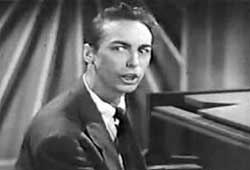 Handsome Harry the Hipster (1944) records Harry's signature song. It starts with a dance club scene with guys in costumes coming awfully close to zute suits, dancing with Betty Grable boogie woogie gals. Handsome Harry the Hipster (1944) records Harry's signature song. It starts with a dance club scene with guys in costumes coming awfully close to zute suits, dancing with Betty Grable boogie woogie gals.
The scene quickly cuts to Harry (conservatively dressed) mugging insanely at his piano while singing: "Handsome Harry the hipster/ The boy with all the chicks/ He plays piano like mad & sings/ He digs those mellow kicks."
Bare in mind that "mellow kicks" really did mean nothing other than getting stoned. What may sound innocent in the sticks, fellow hipsters understood as pitched to their youth culture.
The tune is packed with witty rhymes "Handsome Harry the grifter, man, he will never marry your sister," & a warning about Harry's sister Carey the Clipster. The number includes a wonderful beatnik-style rap long before there were beatniks.
No one who ever saw Harry the Hipster perform could forget him. But as his generation dies off in old folks homes, he's pretty much forgotten by newer generations, though some yunkers may remember one of his wackier hits, "Who Put the Benzedrine in Mrs. Murphy's Ovaltine," which made it onto Doctor Demento's playlist, although when he recorded it, it got him blacklisted throughout the recording industry.
On reintroduction to this talent of the past, he might seem to be easily dismissed as a novelty act. Except that his musicianship was too great, & what today looks like exaggerated jive boogie shtick today was pure New York hipster culture for youth of the 1940s.
A comparison would be a late 1960s or early '70s band a group of guys in page boy haircuts, faux-fur vests over puffy-sleeve shirts, & bellbottom trousers with psychedelic paislies. How could that be taken seriously anywhere at any time? Well, it was. And so too Harry the Hipster was the height of hip rather than the height of kitsch.
And so familiar was Harry to hippydom that his career had an unexpected resurrgence in the Beatles era, as he fit right in, reviving old tunes in praise of reefer & bennies, & adding new material about strip clubs & hippy communes.
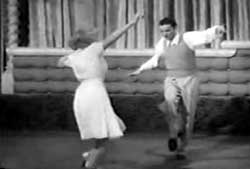 Groovie Movie (1944) is billed in the opening title card as "A Pete Smith Special, Narrated & Produced by a Smith named Pete." Music is provided by Jimmy Dorsey & His Orchestra's recording of Count Basie's "One O'Clock Jump."
Groovie Movie (1944) is billed in the opening title card as "A Pete Smith Special, Narrated & Produced by a Smith named Pete." Music is provided by Jimmy Dorsey & His Orchestra's recording of Count Basie's "One O'Clock Jump."
So you know right away this one-reel film won't be entirely serious. The boogie woogie musical score is by Max Terr.
Arthur Balch is introduced by the narrator as a "top flight hep cat," but his pretty partner isn't introduced at all. What proceeds is a jitterbug instructional done tongue-in-cheek, with historical asides about the dance's origin, not entirely untrue stuff though facts don't stand in the way of an amusing assertion.
We're shown the steps of a simple waltz, then it's speeded up to show that boogie woogie is related to the waltz. Then there's some ballet pirouetting likewise transformed into boogie woogie.
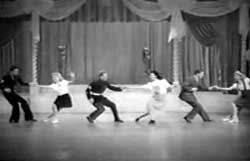 Some of the "technical" terminology for the dance moves is great to learn, & presumedly accurate. One jive-tempo walking-approach called "the hesitation shorty george" is a great example. Some of the "technical" terminology for the dance moves is great to learn, & presumedly accurate. One jive-tempo walking-approach called "the hesitation shorty george" is a great example.
Advice is amusing throughout. "Now that you've learned the basic steps you must now forget them completely. To be a hepcat you've got to pratice plenty. You practice that shoulder stuff & you make with the toes. Again please. Then you swing the wing & whip the hip -- yeah -- while facial expressions are always dignified," this last to homely face-making.
It's all building to a big dance ending with sundry jitterbug couples really going to town, spiced with a couple comedy moves. Two black children also do the jitterbug, & a little tiny guy with a tall disinterested girlfrend, a sailor with a jitterbug sister half his size, shots through the transparent floor, & the happy pianist with soda-pop-bottom glasses looks to be eighty years old.
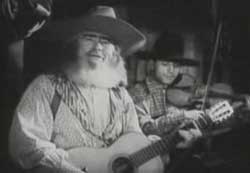 One-reel musical shorts are frequently categorized with soundies. The Last Dogie: A Song Hit Story (1933) features James Melton, with a cowboy swing band introduced immediately singing "Get Along Little Dogie" followed by "Red River Valley."
One-reel musical shorts are frequently categorized with soundies. The Last Dogie: A Song Hit Story (1933) features James Melton, with a cowboy swing band introduced immediately singing "Get Along Little Dogie" followed by "Red River Valley."
As some of the boys are singing, the camera shows a wide range of ranch-hand activities indoors at night: drinking, card playing, rope twirling, poker, not to mention strumming western-swing guitars.
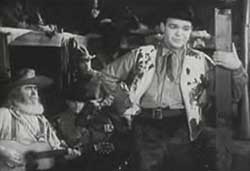 James Melton sings solo "Home on the Range" as the camera cuts to outdoor scenes of range wildlife & men pursuing existence the cowboy way. James Melton sings solo "Home on the Range" as the camera cuts to outdoor scenes of range wildlife & men pursuing existence the cowboy way.
Melton's an Irish tenor & definitely doesn't sound like a western swing singer while soloing. But when the rest of the boys join it it's pure western swing.
They collectively sing "Big Corral" with cuts to scenes of bronco busting, followed by a moment of storytelling about cowboy in frozen snow country in Montana. It's the story of the last dogie, a little calf whose mother froze to death.
Then it's time to sing "The Old Chilsom Trail" with more scenes of cattle ranching cowboy life. In all, it's no Sons of the Pioneers performance but it's pretty good even so.
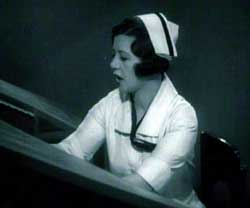 Rudy Valley runs Dr. Vallee's Mkusical Hospital in The Musical Doctor (1932), a one-reel musical comedy & companion piece to Rudy's Musical Justice (1931).
Rudy Valley runs Dr. Vallee's Mkusical Hospital in The Musical Doctor (1932), a one-reel musical comedy & companion piece to Rudy's Musical Justice (1931).
Mae Questal plays a telephone board operator & nurse. Mae's big claim to fame is having been the voice of Betty Boop, & she sang as Betty in Musical Justice. In The Musical Doctor, alas, she does not sing, & it's quite a disappointment.
Rudy was famously good to his friends & had evidently become Mae's pal while making Fleischer cartoons like Kitty from Kansas City (1931) & others.
Dr. Vallee sings to his medical students (these consisting of his back-up singing group The Connecticut Yankees), lyrically providing them with his best advice for helping those who are feeling poorly.
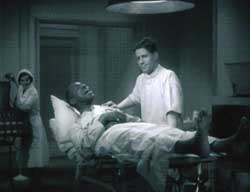 The number is "Keep a Little Song Handy" which he also sings a bit of in the Betty Boop cartoon Rudy Vallee Melodies (1931). It's such a great song for Betty that it was all the more disappointing that there's no chance for Mae Questal to sing it in this film. The number is "Keep a Little Song Handy" which he also sings a bit of in the Betty Boop cartoon Rudy Vallee Melodies (1931). It's such a great song for Betty that it was all the more disappointing that there's no chance for Mae Questal to sing it in this film.
Instead, as a nurse she goes around giving everyone boop-oop-a-doops. One patient can't stand the nurse's boops & Dr. Vallee diagnoses musical starvation. We see an animated insides of his mouth with very lively tonsels. For treatment, Rudy gives a prescription of sundry types of songs.
There's a hospital emergency of a black guy who has, ahem, "black fever." Rudy treats him by singing "Missin' All the Kissin' (from my Alabammy Mammy)" & getting the patient to sing along. Then he cures the guy of missing his mother with a brief quotation from the Jolsen standard "Mammy."
This musical short ends with a reprise of "Keep a Little Song Handy." In all, it's not much of a film, & the comedy falls flat, plus Mae isn't well utilized increasing the disappointment. But I enjoyed it even so.
copyright © by Paghat the Ratgirl
|
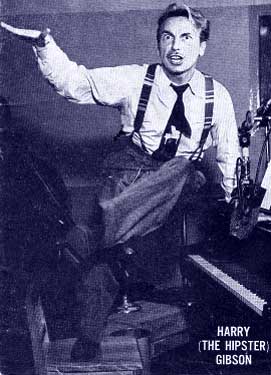

 The daringness of Harry got him in trouble from time to time, as his tune 4-F Ferdinand might convey. In the '40s when many of the film-playing jukeboxes were aimed at soldiers on leave, a tune in praise of a guy who won't be drafted.
The daringness of Harry got him in trouble from time to time, as his tune 4-F Ferdinand might convey. In the '40s when many of the film-playing jukeboxes were aimed at soldiers on leave, a tune in praise of a guy who won't be drafted.

 Some of the "technical" terminology for the dance moves is great to learn, & presumedly accurate. One jive-tempo walking-approach called "the hesitation shorty george" is a great example.
Some of the "technical" terminology for the dance moves is great to learn, & presumedly accurate. One jive-tempo walking-approach called "the hesitation shorty george" is a great example.
 James Melton sings solo "Home on the Range" as the camera cuts to outdoor scenes of range wildlife & men pursuing existence the cowboy way.
James Melton sings solo "Home on the Range" as the camera cuts to outdoor scenes of range wildlife & men pursuing existence the cowboy way.
 The number is "Keep a Little Song Handy" which he also sings a bit of in the Betty Boop cartoon
The number is "Keep a Little Song Handy" which he also sings a bit of in the Betty Boop cartoon